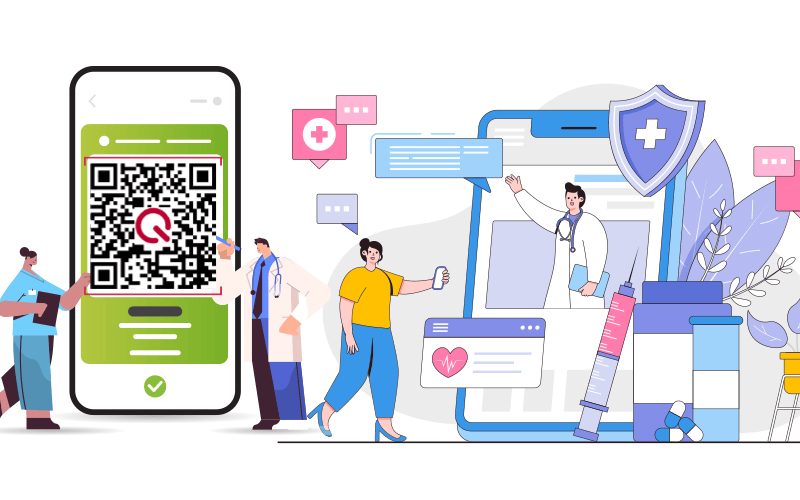
QR Codes in Healthcare: Patient Records and Telemedicine
Accessing healthcare services and managing patient records can often be a complex and time-consuming process. However, QR codes are transforming the healthcare industry, offering streamlined solutions for patient tracking, medication safety, telemedicine, and more.
Let’s explore how QR codes are revolutionizing healthcare and paving the way for more efficient and accessible services.
Key Takeaways
- Improved Patient Management: QR codes provide instant access to electronic medical records (EMRs), ensuring accurate and efficient care.
- Medication Safety: QR codes help track medication history, prevent counterfeit drugs, and guide proper dosages.
- Enhanced Telemedicine: QR codes simplify virtual consultations and connect patients to online healthcare resources.
- Feedback and Data Collection: Healthcare providers can use QR codes to gather patient feedback and improve service quality.
Benefits of QR Codes in Healthcare
1. Easy Access to Medical Information
QR codes link directly to patient data stored in electronic health records (EHRs), offering quick access to:
- Medical history and diagnoses.
- Allergies and current medications.
- Test results and treatment plans.
Example: During emergencies, a QR code on a patient’s wristband can instantly provide paramedics with critical health details.
2. Enhanced Medication Safety
QR codes on medication labels improve safety by providing:
- Instant access to dosage instructions and potential side effects.
- Verification of medication authenticity to prevent counterfeit drugs.
- Tracking of medication history to avoid harmful drug interactions.
Benefit: Elderly patients and caregivers can scan QR codes for precise instructions, reducing errors.
3. Efficient Patient Tracking
Hospitals can streamline patient flow by using QR codes for:
- Admission and discharge processes.
- Real-time location tracking within facilities.
- Linking patients to specific medical equipment or treatments.
Outcome: Improved operational efficiency and reduced paperwork.
4. Simplified Telehealth Services
QR codes enhance telemedicine by connecting patients to:
- Virtual appointments with healthcare professionals.
- Online health resources and educational materials.
- Remote patient monitoring systems.
Example: Patients can scan a QR code to access a virtual waiting room or upload their health data for review.
5. Streamlined Staff Identification and Attendance
QR codes integrated into staff ID badges allow for:
- Automated attendance tracking.
- Quick identification in emergencies.
- Secure access to restricted areas.
Result: Better resource management and enhanced security.
6. Feedback and Reviews
QR codes make it easier to collect patient feedback, allowing providers to:
- Assess service quality through online surveys.
- Identify areas for improvement based on real-time input.
- Build trust by addressing patient concerns promptly.
Tip: Place QR codes in waiting areas or discharge papers for instant feedback collection.
Applications of QR Codes in Healthcare
1. Scheduling Appointments
Patients can scan QR codes to:
- Book appointments directly from posters or websites.
- Receive reminders and updates.
- Reschedule or cancel visits with ease.
Advantage: Reduces administrative workload and enhances patient convenience.
2. Managing Medication and Dosages
QR codes on prescriptions or packaging:
- Provide detailed instructions and warnings.
- Alert caregivers about medication schedules.
- Prevent errors during administration.
Example: A QR code links to a personalized medication plan for chronically ill patients.
3. Accessing Electronic Medical Records (EMRs)
QR codes simplify EMR access by:
- Allowing doctors to retrieve patient data instantly.
- Enabling secure sharing of records across departments or facilities.
- Protecting sensitive information with encryption.
Benefit: Speeds up diagnosis and treatment decisions.
4. Conducting Patient Surveys
QR codes streamline surveys by:
- Directing patients to digital forms with a single scan.
- Collecting feedback on staff performance and service quality.
- Analyzing data to improve patient satisfaction.
5. Supply Chain Management
Healthcare facilities use QR codes to:
- Track inventory levels of medications and equipment.
- Ensure proper handling of sensitive medical supplies.
- Monitor expiry dates to reduce waste.
6. Enhancing Telemedicine
QR codes enable:
- Easy access to telehealth platforms.
- Integration with wearable devices for remote monitoring.
- Direct links to virtual consultation rooms.
Example: Patients scan a QR code to join a video call with their doctor.
How to Create Safe and Effective QR Codes in Healthcare
- Choose a Reliable QR Code Generator: Use a secure platform that encrypts sensitive data.
- Optimize Design: Ensure codes are easy to scan with clear instructions.
- Test Across Devices: Verify functionality on various smartphones and apps.
- Regularly Update Content: Keep linked information accurate and up-to-date.
- Monitor Usage Analytics: Track scans to measure effectiveness and identify improvements.
The Role of QR Codes in Patient Records
QR codes enhance patient record management by:
- Allowing immediate access to detailed health information.
- Ensuring accuracy during treatment transitions.
- Reducing reliance on physical records.
Benefit: Improved collaboration among healthcare providers and faster emergency response.
The Role of QR Codes in Telemedicine
QR codes streamline telemedicine by:
- Enabling seamless access to virtual care services.
- Facilitating secure transfer of medical records.
- Providing links to post-appointment resources and follow-ups.
Result: Improved accessibility for patients in remote or underserved areas.
Best Practices for QR Codes in Healthcare
- Ensure Security: Use encrypted codes to protect patient data.
- Include Clear Call-to-Actions: Guide users on what the QR code does.
- Design for Accessibility: Use high contrast and simple layouts.
- Utilize Dynamic QR Codes: Update linked content without changing the code.
The Future of QR Codes in Healthcare
As healthcare embraces digital transformation, QR codes will:
- Enhance interoperability between providers.
- Expand use in AI-driven diagnostics and remote monitoring.
- Facilitate personalized patient education and engagement.
Conclusion
QR codes are a game-changer in healthcare, simplifying processes, improving access to care, and enhancing patient safety. By adopting QR code technology, healthcare providers can deliver efficient, patient-centered services and pave the way for a more connected and accessible future.